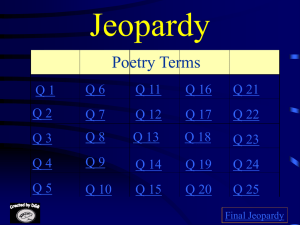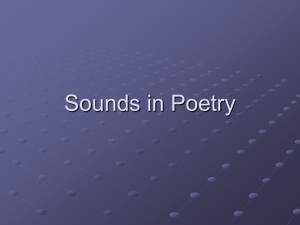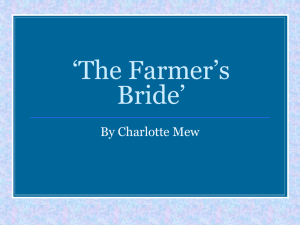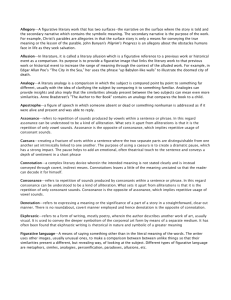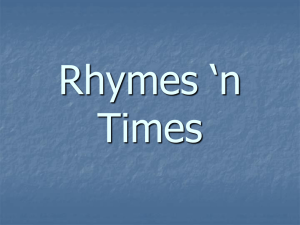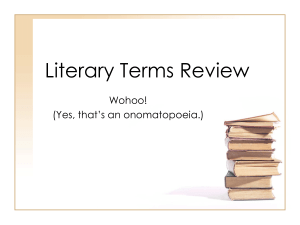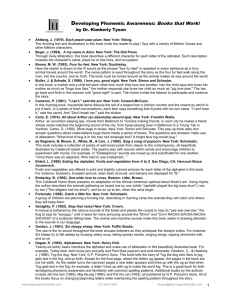LITERARY DEVICES: Dialogue Dialogue is the conversation that
advertisement
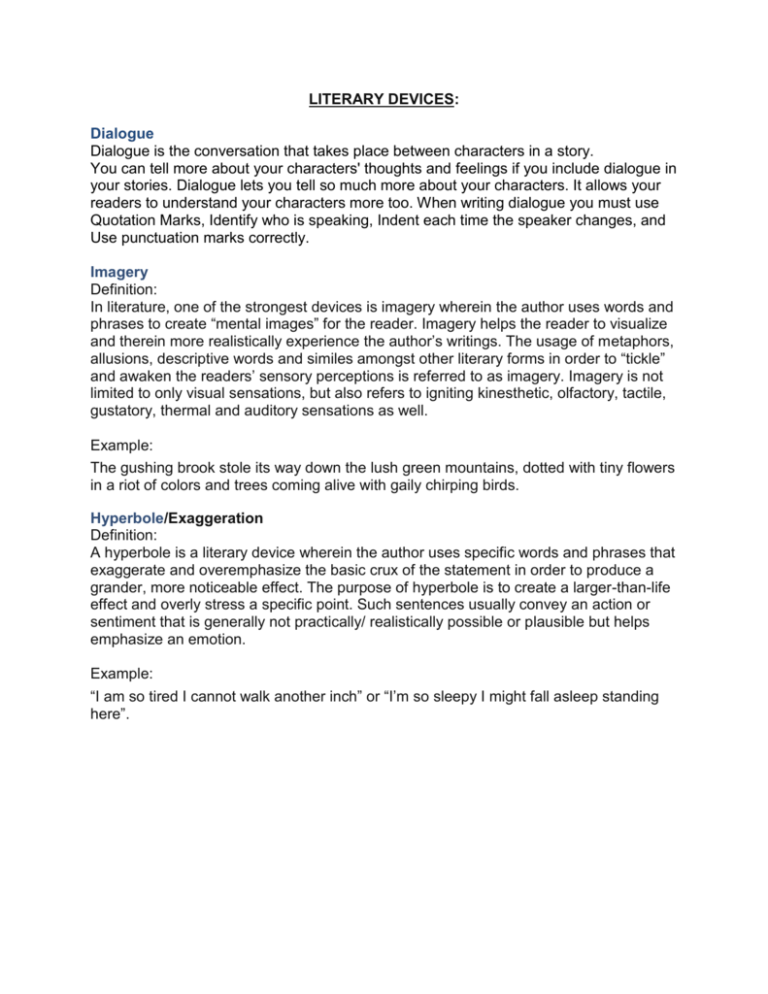
LITERARY DEVICES: Dialogue Dialogue is the conversation that takes place between characters in a story. You can tell more about your characters' thoughts and feelings if you include dialogue in your stories. Dialogue lets you tell so much more about your characters. It allows your readers to understand your characters more too. When writing dialogue you must use Quotation Marks, Identify who is speaking, Indent each time the speaker changes, and Use punctuation marks correctly. Imagery Definition: In literature, one of the strongest devices is imagery wherein the author uses words and phrases to create “mental images” for the reader. Imagery helps the reader to visualize and therein more realistically experience the author’s writings. The usage of metaphors, allusions, descriptive words and similes amongst other literary forms in order to “tickle” and awaken the readers’ sensory perceptions is referred to as imagery. Imagery is not limited to only visual sensations, but also refers to igniting kinesthetic, olfactory, tactile, gustatory, thermal and auditory sensations as well. Example: The gushing brook stole its way down the lush green mountains, dotted with tiny flowers in a riot of colors and trees coming alive with gaily chirping birds. Hyperbole/Exaggeration Definition: A hyperbole is a literary device wherein the author uses specific words and phrases that exaggerate and overemphasize the basic crux of the statement in order to produce a grander, more noticeable effect. The purpose of hyperbole is to create a larger-than-life effect and overly stress a specific point. Such sentences usually convey an action or sentiment that is generally not practically/ realistically possible or plausible but helps emphasize an emotion. Example: “I am so tired I cannot walk another inch” or “I’m so sleepy I might fall asleep standing here”. Point of View Definition: In literature, the ‘point of view’ is a literary device that depicts the manner in which a story is narrated/ depicted and who it is that tells the story. Simply put, the point of view determines the angle and perception of the story unfolding, and thus influences the tone in which the story takes place. The point of view is instrumental in manipulating the reader’s understanding of the narrative. In a way, the point of view can allow or withhold the reader access into the greater reaches of the story. Two of the most common point of view techniques are the first person, wherein the story is told by the narrator from his/ her standpoint and the third person wherein the narrator does not figure in the events of the story and tells the story by referring to all characters and places in the third person with third person pronouns and proper nouns. Example: In the popular Lord of the Rings book series, the stories are narrated in the third person and all happenings are described from an “outside the story” point of view. Contrastingly, in the popular teen book series, Princess Diaries, the story is told in the first person, by the protagonist herself. Types of Point of View: 1st person – told from the main character’s perspective, uses 1st person pronouns (I, me, my) 3rd person limited – the narrator is an outsider who only can see into one character’s thoughts and feelings 3rd person omniscient – the narrator is an outsider who can get into all of the character’s thoughts and feelings SOUND DEVICES Alliteration Definition: Alliteration is a literary device where words are used in quick succession and begin with letters belonging to the same sound group. Whether it is the consonant sound or a specific vowel group, the alliteration involves creating a repetition of similar sounds in the sentence. Alliterations are also created when the words all begin with the same letter. Alliterations are used to add character to the writing and often add an element of ‘fun’ to the piece.. Example: The Wicked Witch of the West went her own way. (The ‘W’ sound is highlighted and repeated throughout the sentence.) Assonance Definition: Assonance refers to repetition of sounds produced by vowels within a sentence or phrase. In this regard assonance can be understood to be a kind of alliteration. What sets it apart from alliterations is that it is the repetition of only vowel sounds. Assonance is the opposite of consonance, which implies repetitive usage of consonant sounds. Example: “A long song”. (Where the ‘o’ sound is repeated in the last two words of the sentence) Rhyme Scheme Definition: The rhyme scheme is the practice of rhyming words placed at the end of the lines in the prose/ poetry. Rhyme scheme refers to the order in which particular words rhyme. If the alternate words rhyme, it is an “a-b-a-b” rhyme scheme, which means “a” is the rhyme for the lines 1 and 3 and “b” is the rhyme affected in the lines 2 and 4. Example: Roses are red (a) Violets are blue (b) Beautiful they all may be (c) But I love you (b) The above is an “a-b-c-b” rhyme scheme. Rhythm & Rhyme Definition: The concept of ‘rhythm and rhyme’ refers to a pattern of rhymes that is created by using words that produce the same, or similar sounds. Rhythm and rhyme together refer to the recurrence of similar sounds in prose and poetry, creating a musical, gentle effect. Example: “I am a teapot Short and stout; This is my handle And this is my spout. When the water’s boiling Hear me shout; Just lift me up And pour me out” Onomatopoeia Definition: The term ‘onomatopoeia’ refers to words whose very sound is very close to the sound they are meant to depict. In other words, it refers to sound words whose pronunciation to the actual sound/noise they represent. Example: Words such as grunt, huff, buzz and snap are words whose pronunciation sounds very similar to the actual sounds these words represent. In literature such words are useful in creating a stronger mental image. For instance, sentences such as “the whispering of the forest trees” or “the hum of a thousand bees” or “the click of the door in the nighttime” create vivid mental images.

